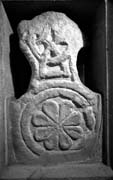Select a site alphabetically from the choices shown in the box below. Alternatively, browse sculptural examples using the Forward/Back buttons.
Chapters for this volume, along with copies of original in-text images, are available here.
Object type: Cross-arm and central roundel
Measurements: H. 31 cm (12 in); W. 16 cm (6.25 in) top of arm; 15.5 cm (6 in) across centre; 18.5 cm (7.25 in) total width D. of arm 10.5 cm (4.25 in)
Stone type: Appears to be a medium-grained oolite with ooliths standing proud. Probably Portland stone, Portland Freestone Member, Portland Limestone Formation, Portland Group, Upper Jurassic
Plate numbers in printed volume: Pls. 45-6
Corpus volume reference: Vol 7 p. 98-9
(There may be more views or larger images available for this item. Click on the thumbnail image to view.)
A (broad): The portion of the cross which survives is distinctively shaped since the arm has a fan-shaped tip and is waisted towards the larger central roundel. In the centre is a very worn eight-petalled rosette surrounded by a triple moulding: two flat-band mouldings enclosing a ring of pellets. The arm is completely filled by a stout palm tree with curving oval leaves.
B (narrow): Plain, sides of upper arm dressed smooth.
C (broad): The centre is filled by an eight-petalled rosette surrounded by two flat-band mouldings; the petals are hollowed slightly. In the cross-arm is part of a knot with a bar terminal and median-incised strands. Part of the knot is chipped away.
D (narrow): May be cable border.
Although the shape of this cross-arm is unusual, the plain cross-head from Amesbury has a similar rounded terminal (Amesbury 2, Ill. 389). It would seem as though face A was the main face since it was the more elaborately decorated and, if painted, the circles of pellets would have resembled metalwork. The 'tree' can be seen as a variant of 'the sacred tree', a motif which is ultimately of Sassanian origin but which via the Middle East was translated into Christian art of the West (Dalton 1911, 699–700). In Carolingian manuscripts there are similar exotic plants which seem to combine the palm and the vine and can have a cross sprouting from the tip (see BL Harley MS 2788, fol. 6v: Braunfels and Schnitzler 1966, pl. V). There is no obvious diagnostic dating evidence, since such motifs could have been copied at any time, but it is possible that this is a product of the same orientalising taste as is found at East Stour (pp. 101–2).



